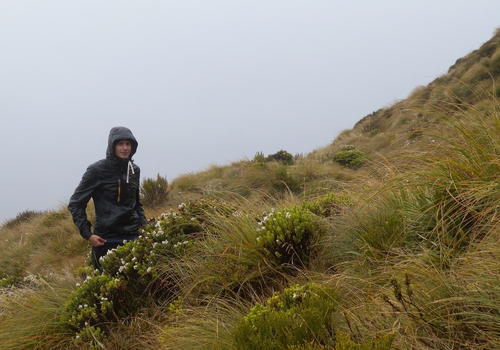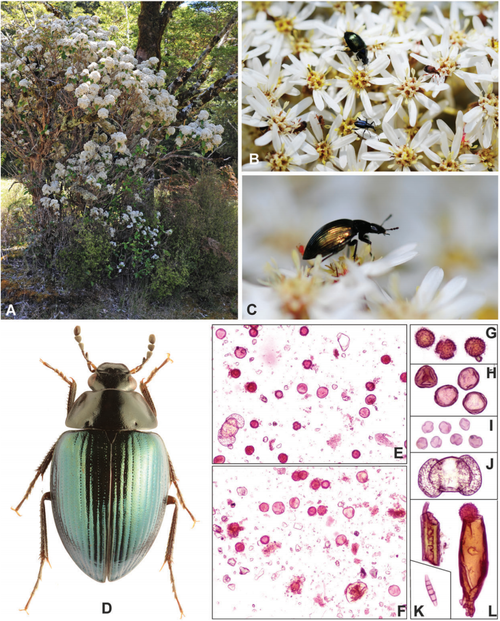 In my project I investigate the systematics, phylogenetics and biogeography of terrestrial water beetles across the Southern Hemisphere. This relict group of beetles is called Cylominae and it is restricted to New Zealand, Australia, South Africa, Chile and Peru. In our fieldwork in New Zealand and South Africa we discovered many new species and genera that will result in several publications.
In my project I investigate the systematics, phylogenetics and biogeography of terrestrial water beetles across the Southern Hemisphere. This relict group of beetles is called Cylominae and it is restricted to New Zealand, Australia, South Africa, Chile and Peru. In our fieldwork in New Zealand and South Africa we discovered many new species and genera that will result in several publications.We described the new South African genus and species Relictorygmus trevornoahi, the only genus of the subfamily in Africa. We also explored the biology of the flower visiting water beetle Rygmodus. Our results revealed that beetles are pollen feeding with larvae that live in aquatic habitat, a combination that is absolutely unique for water beetles. After finishing all the molecular work, we will reconstruct the migratory and vicariant events that shaped the diversity of this Gondwanan group.
With the fieldwork in New Zealand and South Africa I was able to experience the habitats of my beetles as well as the culture of the countries. BIG4 inspired me to continue working in taxonomy and phylogenetics and showed me that this basic science offers great career opportunities.

To get a more detailed view on short-term evolutionary change of Southern hemisphere beetles we started a project in cooperation with the BIG4 student Daniel Marquina and biogeographer Dr. Isabel Sanmartin. We focused on the evolution and its biogeographic implications of leaf litter beetles across North and South Island in New Zealand. New Zealand is famous for its endemism and landscape diversity that has resulted in the evolution of some enigmatic animals such as the kiwi. Since research on beetles, especially the leaf litter communities, is scarce it perfectly suits our purpose and might result in much deeper understanding of the evolutionary drivers in New Zealand. Currently, we have 40 samples of leaf litter beetle communities from our 2016 fieldwork. With environmental DNA extraction techniques and next generation sequence we generated sequences of three mitochondrial genes that will be the basis of upcoming analyses.
BIG4 enabled me to meet my scientific heroes on conferences and to connect with scientist around the world. With those new cooperators and the BIG4 workshops I learned a lot about the morphology of my focus groups as well as the molecular methodology to study them in a broader evolutionary context.
Publications within the project:
- Seidel, M., Arriaga-Varela, E., & Fikáček, M. (2016). Establishment of Cylominae Zaitzev, 1908 as a valid name for the subfamily Rygmodinae Orchymont, 1916 with an updated list of genera (Coleoptera: Hydrophilidae). Acta Entomologica Musei Nationalis Pragae, 56(1), 159-165.
- Minoshima, Y. N., Seidel, M., Wood, J. R., Leschen, R. A., Gunter, N. L., & Fikáček, M. (2018). Morphology and biology of the flower‐visiting water scavenger beetle genus Rygmodus (Coleoptera: Hydrophilidae). Entomological Science.
- Seidel, M., Minoshima, Y. N., Arriaga-Varela, E., & Fikáček, M. (2018, June). Breaking a disjunct distribution: a review of the Southern Hemisphere genera Cylorygmus and Relictorygmus gen. nov. (Hydrophilidae: Cylominae). In Annales Zoologici (Vol. 68, No. 2, pp. 375-402). Museum and Institute of Zoology, Polish Academy of Sciences.
- Toussaint E. A. F., Seidel M., Arriaga-Varela E., Hájek J., Král D., Sekerka L., Short A. E. Z. & Fikáček M. (2017) The peril of dating beetles. Systematic Entomology 42(1): 1-10

